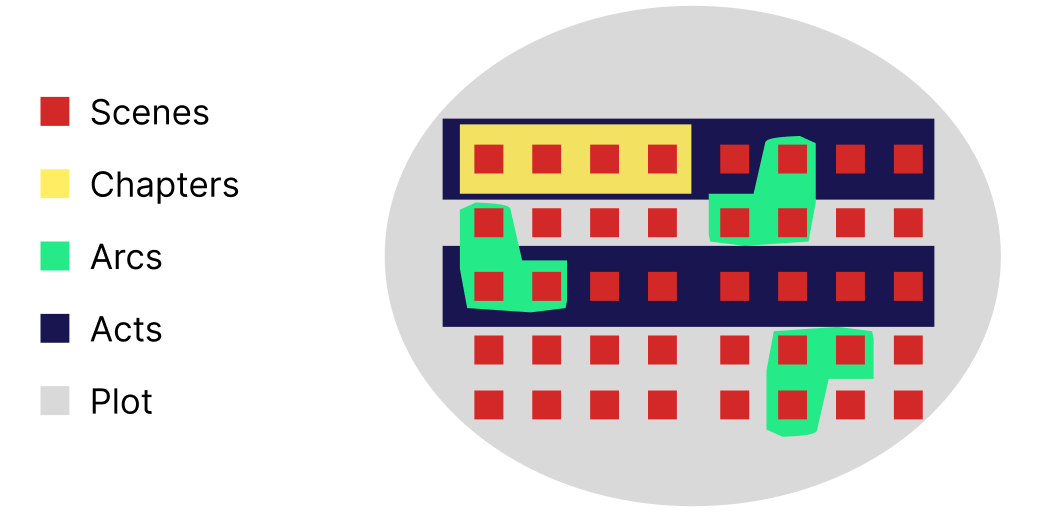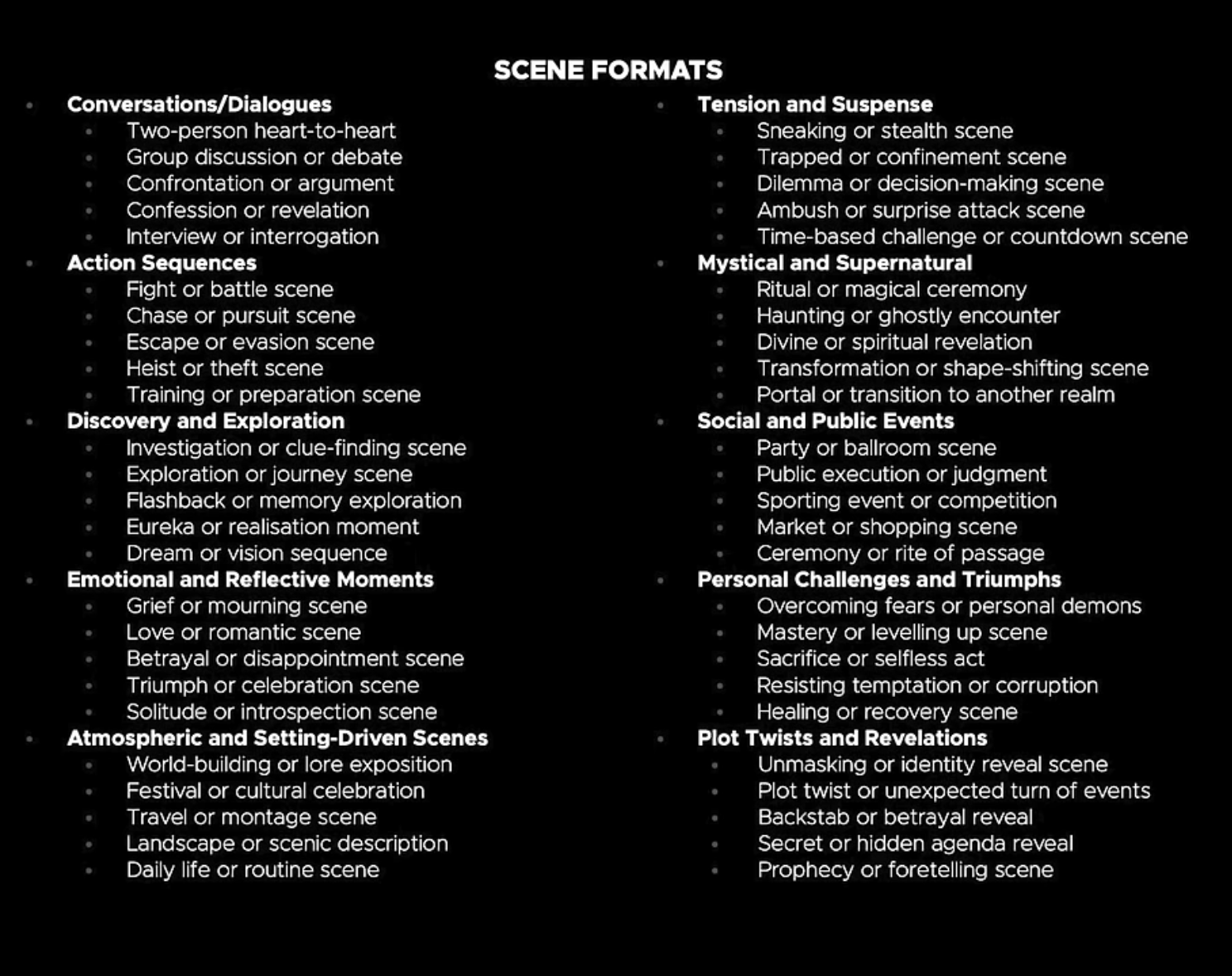Story Anatomy
Breaking down the architecture of storytelling, here are the essential elements of a story, from smallest to largest

- Scenes
- Chapters
- Beats
- Arcs
- Acts
- Plots
1. Scenes
The Building Blocks
It's the smallest, most immediate element of your story. It is a self-contained unit of action, and it is usually tied to a single location and a single event. It is a combination of time and place, with a clear beginning, middle, and end. It focuses on a particular interaction or event, showcasing characters' actions, dialogue, and reactions.
Purpose Scenes drive the immediate narrative forward, revealing character, conflict, and information. They create a sense of immediacy and engagement. It's basically answers the question, and what happened next?
A tense confrontation between two characters in a dimly lit alleyway, a character discovering a hidden letter in their grandmother's attic, or a group of friends celebrating a birthday at a restaurant.

2. Chapters
Organizing the Scenes
Chapters are like containers that group related scenes together. They provide structure and pacing to your narrative. They are divisions within a larger work, often marked by a change in time, place, perspective, or focus. They serve to break the story into manageable chunks.
Purpose
Chapters allow for shifts in narrative focus, provide natural pauses for the reader, and create a sense of progression. They can also be used to create suspense or highlight specific themes. The end of a chapter usually indicate to your readers that they can take a break at this moment.
A chapter might cover a single day in a character's life, a journey to a specific location, or the unfolding of a particular mystery. The chapter ending is often a mini cliffhanger, or a moment of reflection.
3. Beats
Big moments
Beats represents the significant moments or plot points in a arc or story(which is essentially the encompassing arc). It represents key moments and decisions that propels the story forward by introducing new conflicts, resolving old ones or revealing important information
Purpose
Quickly address an arc by identifying the points or actions of an arc or the entire story.
Types
You can adapt the beats to your genre.
- Opening Image: What is the world like?
- Reveal theme: Show the central problem or question
- Setup: Show what user's life is like, the status quo of the protagonist
- Catalyst: Sudden turn of event to disrupt the status quo
- Debate: Contemplate how to handle new change
- Divergence: New status quo, after the hero accepts the new change
- B story: Introduce new story line, like love interest, new challenge
- Break: Protagonist having fun, Lighthearted section, a respite from the challenge, a calm before the storm.
- Twist: A major turning point, revelation that raises the stake or changes the story significantly
- In a bind: The antagonist gains upper hand, like they are closing in on the protagonist or time is running out.
- All is lost: Rock bottom, the challenge seems inevitable
- Reflection: After a devastating loss, the protagonist reflects on their journey
- Strategy: The protagonist devise a plan, perhaps they must act or gain new information
- Finale: Face off, where the central conflicts is resolved
- Final Image: Closure, how the story ends and the current final status.
Example:
- A boy goes to school and told a friend about being beaten by his parent (Opening image)
- Friend suggest they tell a teacher but he disagree
- Friends tell teacher anyways
- the police arrest parent
- Argues with friend, and friendship is broken but the character was forthcoming with the police
- Friends find out he was lied to, that the boy was never abused (Twist)
- Friends feels sympathy and finds a way to expose the boy (Strategy)
- Friend accused the boy, and secretly records conversation where the boy confirms the true (Finale)
- Friend's parent are released and Boy is taken to see a therapist or something (Final Image)
4. Arcs
Character and Story Development Over Time
Arcs represent the broader trajectory of a character or storyline. They span multiple chapters and scenes, showcasing growth, change, and development. Usually, one or more character's arcs are addressed the book, it is a sustained development over a significant portion of the narrative.
Characters, Plot or Themes
- A character arc address the story of a single character, addresses the beginning, the middle and the end of their story or growth.
- Plot arcs are basically mini-plots, plots within a plot.
- Thematic arcs addresses a central idea or theme like power, poverty, love etc
Purpose
Arcs provide depth and complexity to the narrative, creating a sense of meaningful change and progression. They ensure that the story doesn't feel static or episodic.
A character arc might involve a protagonist overcoming their fears and insecurities, or a villain experiencing a moral awakening. A plot arc might involve the gradual unraveling of a conspiracy or the escalating conflict between two factions. A thematic arc could be the exploration of the idea of forgiveness throughout the novel.
5. Acts
This represents the beginning, the middle and the end of your story or an arc. It address the following issues
- Status quo: What is the story and the character(s) like
- The question: What is the challenge the hero will face
- The answer: How will the question be answered? What will the character(s) do
- The aftermath: What is the result of the actions? How did the hero fare against the challenge?
This can be represented with a simple 3 act structured, but there are other types too.
Three Acts Structure
This is the most common pattern used
- Exposition: Inciting incident or catalyst. This represents about 25% of the story. It addresses the status quo and the question
- Confrontation: the midpoint of the book, usually the biggest and core of the story, takes about 50% of the story. It addresses the character's actions
- Resolution: the climax, the end of the story, with happy ending or disastrous consequences, takes the remaining 25%.
One Act Structure
This is used for short dramas, usually an anthology or a long description of an event in a dramatic way.
Five Act Structure
This is basically an expansion on the 3-act structure, expanding the number of distinct sections in the story.
- Exposition: Similar to Three Acts structure, it shows the status quo and introduces the inciting incident that threatens or changes the status quo
- Turning point: This is where the hero accepts the challenge and learns about the new status quo as things becomes progressively complex
- Rising action and climax: This is the apex of the challenge, where the user faces a big reality check or defeat, and might even consider quitting their journey. This is also the point where the hero truly commits because they have all the facts
- Falling action: The hero recalibrates or adjust the approach, worldview, desires, beliefs etc in a way that makes them better or worse for the story depending on the goal of the story. It's a turning point in their story, where the story uses the final suspense to destroy the hero or give the hero hope.
- Resolution: This is the end of the story, happy or disastrous ending.
Four Acts
More common in East asian, called Kishōtenketsu stories. There is a slight regional differences between Chinese, Korean, Japanese and Vietnamese variants, but there are the basics.
- Introduction: Status quo, where the characters are introduced, and also the challenges, central themes or issues are presented to the user. For example, the character is poor and really struggling.
- Change: Something come up, that the hero must address. This is merely used for self-realisation, where the user must consider all their options. For example, the character's mum needs a surgery, he realises there is no way he could afford it and his mother could die because of his poverty.
- Action: The response, crescendo. For example, in the last act, the character realises they have to work harder, so they do, or realises that the only way to make money is through crime, so becomes a bank robber, start robbing banks etc.
- Resolution: The result, how does it all end, what are lesson learnt, did the character achieve their goal?
Two acts
Used in things like comedies where there are no conflicts just exposition and resolution. It could also mix exposition with conflict, starts right in the middle of conflict and end with resolution.
6. Plots
The Overall Narrative Framework
Plot is just an arc. In short, it is the story arc, and depending on the story, the arc of your protagonist.
The plot is the overarching sequence of events that make up the story. It's the grand design that encompasses all the scenes, chapters, and arcs. It is the causal chain of events that drive the narrative forward. It typically involves a conflict, a rising action, a climax, and a resolution.
Purpose
The plot provides the structure and direction of the story, ensuring that it has a clear beginning, middle, and end. It creates a sense of purpose and momentum.
A classic plot structure might involve a hero's journey, a romantic comedy, or a mystery thriller. The plot is the answer to the question "What happens?"
How They Work Together:
- Scenes are the fundamental units that build chapters.
- Chapters organize scenes and contribute to the development of arcs.
- Arcs contribute to and are contained within the overall plot.
- The plot provides the overarching framework that ties everything together.
In essence:
- Scenes: What is happening right now?
- Chapters: What happened in this section of the story?
- Arcs: How did this character/plot line change or develop over time?
- Plots: What is the whole story about?
